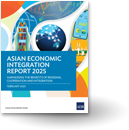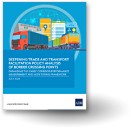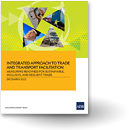Spotlight Archives
- ADBI Working Paper: Asia-Latin America Free Trade Agreements: An Instrument for Inter-Regional Liberalization and Integration?September 2012G. Wignaraja, D. Ramizo and L. Burmeister examine the extent of liberalization of all Asia-Latin America FTAs in effect from 2004 to June 2012. Their analysis shows that most inter-regional FTAs cover liberalization of goods and services including some behind the border regulatory barriers. Read more.
- ADB Policy Brief No.3: Provision of Regional Public Goods—Best Practices and Role of Regional Development BanksSeptember 2012OREI Policy Brief examines the role of Regional Development Banks (RDBs) in the provision of regional public goods in the process of promoting regional cooperation and integration. It highlights best practices using case studies from Asia, Latin America, and Africa. Read more.
- ADB Working Paper Series on Regional Economic Integration No. 101 - Different Types of Firms, Products, and Directions of Trade: The Case of the People's Republic of China24 August 2012H. Lee, D. Park, and J. Wang perform an in-depth empirical analysis of trade in manufactured goods of the People's Republic of China. Their analysis yields a number of new stylized facts about the country's exports and imports. Read more.
- ADB Policy Brief No.2: Can Aid for Trade enhance human capacity shortfalls in Asia's LDCs and SIDS?August 2012OREI Policy Brief explores the role of human resource gaps in the divergence between potential gains from regional integration and realized gains in Asia's least developed and small island states. It points that cooperation with the private sector and regional cooperation can enhance the benefits of limited aid for trade flows while accounting for their shortfalls. Read more.
- Asian Economic Integration Monitor (AEIM)July 2012This inaugural issue of the AEIM combines two important elements of ADB’s knowledge portfolio—regional economic and financial monitoring and assessing progress in regional cooperation and integration. The July 2012 AEIM features a special section—“Regional Integration: A Balanced View.” Read more | Download report | Watch video
- Pacific Economic Monitor July 2012July 2012This edition of the Pacific Economic Monitor discusses mid-year updates to 2012 and 2013 GDP growth and inflation projections for ADB's Pacific developing member countries. Read more.
- Live Online Discussion: Will Asia continue to integrate its economies?July 2012Office of Regional Economic Integration Head Iwan J. Azis and Principal Economist Lei Lei Song—two of ADB’s leading experts on integration and cooperation—responded to questions in a live online chat 23 July. Read transcript.
- ADB Working Paper Series on Regional Economic Integration No. 100: Narrowing the Development Divide in ASEAN: The Role of PolicyJuly 2012J. Menon argues that there is a pressing need to increase the pace and breadth of policy reforms in order to address the huge gaps that remain between ASEAN-6 and Cambodia, Lao PDR, and Viet Nam. Read more.
- ADB Working Paper Series on Regional Economic Integration No. 99: The Impact of ACFTA on People’s Republic of China-ASEAN Trade: Estimates Based on an Extended Gravity Model for Component TradeJuly 2012Y. Sheng, H.C. Tang, and X. Xu use an extended gravity model to shed light on the impact of a free trade area agreement between ASEAN and the People's Republic of China on members‘ trade flows and trade patterns. Read More.
- ADB Working Paper Series on Regional Economic Integration No. 98: ASEAN-China FTA and the Competitiveness of Local Industries: A Case Study of Major Industries in the Lao PDRJuly 2012L. Leebouapao, S. Insisienmay, and V. Nolintha assess the effect of the ASEAN–China Free Trade Agreement (ACFTA) on wood processing, cement, and motorcycle assembly in the Lao PDR. The paper finds that the ACFTA will have sizable but varying degrees of impact on the three industries. Read more.




